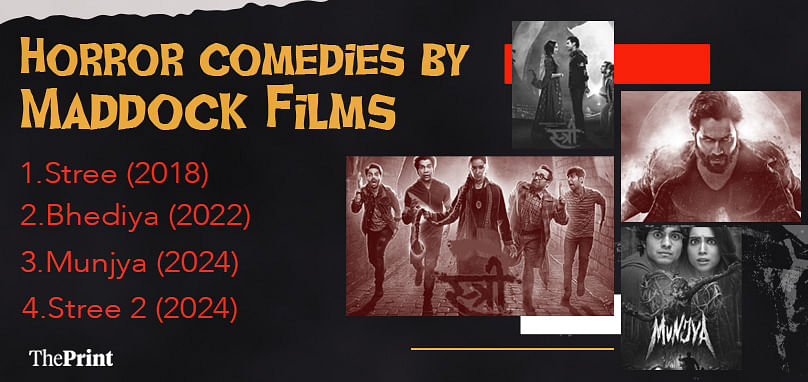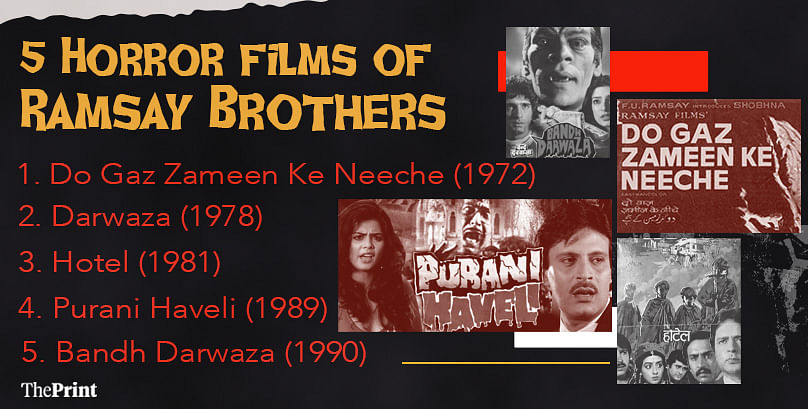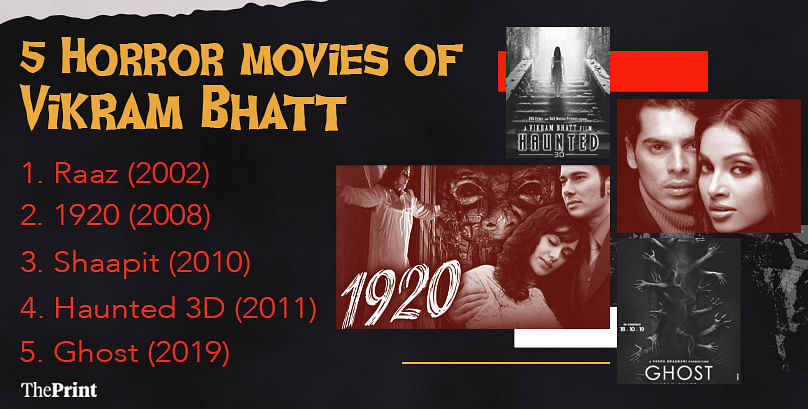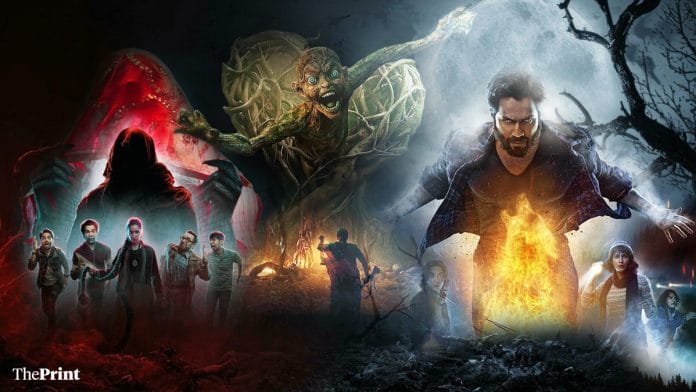New Delhi: Horror is the antithesis of comedy. But when melded together, they hold the promise of a box-office hit. And Bollywood has been cashing in on this subgenre with increasing success.
From Stree in 2018 to Bhool Bhulaiyaa 2 and Bhediya in 2022 to Stree 2: Sarkate Ka Aatank and Munjya this year, directors and scriptwriters are experimenting with comedy to drive home the horror.
The niche fanbase is now mass. Werewolves howl to Himesh Reshamiyya’s Tera Suroor, a screeching boy ghost fears the grandmother’s rod, and a detached head chases petrified men on bikes. New-age Bollywood directors are marrying jump scares with high jinks.
Dinesh Vijan, movie producer and founder of entertainment company Maddock Films, teamed up with filmmaker Amar Kaushik to deliver one of the most successful horror comedies in Hindi cinema–Stree. And they did it without riding on the coattails of a big star. Stree 2: Sarkate Ka Aatank has become a blockbuster, earning Rs 586 crore in India and surpassing the lifetime collections of Shah Rukh Khan’s Jawan (2023) in the Hindi market. Kaushik is also the director of Varun Dhawan-starrer Bhediya and the producer of Munjya.

“In Hollywood, horror comedies like the Scream franchise or even What We Do in the Shadows (2014) are more like spoofs or reactions to existing horror films. Amar Kaushik developed Stree by blending the two seemingly disparate concepts [horror and comedy],” said Srishti Walia, a PhD scholar of Cinema Studies at Delhi’s Jawaharlal Nehru University.
Horror in Bollywood has gone through many iterations. The 1970s and ’80s were dominated by over-the-top offerings from the Ramsay Brothers like Do Gaz Zameen Ke Neeche (1972), Hotel (1981) and Bandh Darwaza (1990). This was followed by Vikram Bhatt’s brand of sultry horror, which featured films like Raaz (2002) and Haunted–3D (2011), and Ram Gopal Varma’s Bhoot (2003).

Now, horror-comedy is enjoying its moment.
“The reason the recent films have been successful is also a reassessment of taste and more acceptance of genre films. Film festivals are genre-friendly—horror films are winning awards at festivals, and there is an emerging trend of revisiting old, pulpy horror films,” said Vibhushan Subba, professor of cinema studies at JNU’s School of Arts and Aesthetics.
Newer offerings like Stree and Stree 2, Bhediya and even Munjya have an appeal that is at once hyperlocal and universal. The Stree universe, for instance, is set in the small town of Chanderi which is haunted by a witch who only attacks men, and in the sequel, by a sexist monster who abducts free-thinking ‘modern’ women. Bhediya, a horror comedy about a man who turns into a werewolf, unfolds in the forests of Ziro in Arunachal Pradesh. Munjya begins in a middle-class Punjabi-Marathi household in Pune and moves to a village on the serene Konkan coastline.
When you try to ‘give gyaan’ (preach) no one likes it. So, we were clear that entertainment comes first. People who do not get the message can also enjoy it. For those who get it, it will be an added bonus for us – Amar Kaushik, director, Stree, Stree 2 and Bhediya
The makers’ family-focused approach has also worked, broadening the appeal of their films. “Most of the earlier horror films did have the element of sensuality to them. We wanted to change that. That is why the numbers are also bigger,” said Niren Bhatt, who wrote the script for Stree 2.
Also read:
No toxic masculinity
In Stree 2, protagonist Vicky (Rajkummar Rao)’s love interest saves him and his three friends from the headless demon ‘Sar Kata’. Wielding her braid that glows a brilliant silver, the unnamed woman, played by Shraddha Kapoor, fearlessly fights off the evil entity. With this, the movie inverts the damsel in distress trope. In its prequel, Stree, the witch haunting Chanderi only targets men who permit her to do so by acknowledging her call and looking into her eyes.

The key to success is a kind of storytelling that does not sacrifice entertainment at the altar of sanctimony or sleaze.
“I decided to create the Stree universe while working on the story of Bhediya. The way to do it was through the character of Jana/Janardan (Abhishek Banerjee),” said Kaushik. In both Stree and Stree 2, it is Jana, Vicky’s friend, who gets possessed by supernatural elements.
The character is also one of the most popular ones from the franchise. Interestingly, Kaushik instructed Banerjee to watch Raj Kapoor’s scenes from Jis Desh Mein Ganga Behti Hai (1960), to perfect his role of the innocent, clueless bumpkin.

“I think it is Jana’s innocence that has captured the frenzy of the audience. People have recognised me on the streets and called me by the character’s name. He embodies a kind of innocence, that too in a male character, that is absent in films today,” said Banerjee.
What’s interesting is that none of the heroes—Vicky, Bittu (Abhay Verma) in Munjya and Bhaskar (Varun Dhawan) in Bhediya—embody toxic masculinity. Bhaskar starts out as an aggressive and arrogant young man from Delhi, but undergoes a transformation, literal and metaphorical, as he immerses into the way of life in Arunachal Pradesh.
Our way of conceptualising a story is talking to people of the region, listening to the stories they have heard growing up, and then writing the script. That adds to the authenticity of the story as well – Niren Bhatt, writer of Stree 2
Vicky is what Gen Z calls ‘pookie’ – an affectionate nickname for cute people. He is a softhearted and adorable ladies’ tailor who gets scared and even cries at the prospect of danger. Expressing emotion doesn’t make him less of a man.
Bittu works in his mother’s beauty parlour, and despite being quietly in love with Bela (Sharvari Wagh), does not try to impede her relationship with her boyfriend. What is even better is that none of these male characters are lauded for basic decent behaviour.

“We wanted to show regular guys who get scared. Not heroes who beat up 10 men or can save anyone. No, these are just everyday men who experience what normal people do,” said Kaushik.
Instead, fighting evil is shown as a collaborative process, which women viewers have so far loved.
Kaushik recalled watching Stree 2 at a theatre in Kanpur to gauge the audience’s response properly. “It was heartening to hear even the women laugh and clap, and enjoy the movie,” he said.
Most of the earlier horror films did have the element of sensuality to them. We wanted to change that. That is why the numbers are also bigger – Niren Bhatt, writer of Stree 2
A consummate entertainer, Kaushik knew that movies with a strong moral and social message hardly see commercial success. So he packaged the complex themes of patriarchy, feminism and generational trauma into refreshing films, using both subtle and overt humour to get his point across.
“When you try to ‘give gyaan’ (preach) no one likes it. So, we were clear that entertainment comes first. People who do not get the message can also enjoy it. For those who get it, it will be an added bonus for us,” said Kaushik.
Also read: Bastar to Article 370—Bollywood propaganda movies boosting BJP soft power
Exploring small-town charm
Bhediya, Stree, Stree 2 and Munjya bring small towns and villages back into focus–Chanderi in Madhya Pradesh, the fictional Chetukwadi in the Konkan belt, and the quaint Ziro in Arunachal Pradesh. Unlike older horror films, these stories do not occur in secluded mansions in the middle of nowhere. They unfold in places that buzz with life and idiosyncratic characters, even showcasing the unique cultural elements of those regions.
“Our way of conceptualising a story is talking to people of the region, listening to the stories they have heard growing up, and then writing the script. That adds to the authenticity of the story as well,” said Niren Bhatt, writer of Bhediya and Stree 2. Setting the movies in off-beat locations in Madhya Pradesh and Arunachal Pradesh has been a gamble that has paid off for Maddock.
Bhediya looks not just at the insider-outsider issue that has been consistent in many parts of the Northeast, but also the racism residents face—when they move out of the state or when tourists visit their home turf. Through the character of Jomin (Paalin Kabak), who vents his frustration at the casual racism of both Janardhan (Banerjee) and Bhaskar, Kaushik tells his audience why such discrimination is hurtful.

Kaushik was adamant about shooting on location in Arunachal Pradesh despite bad roads, the absence of proper hotels, and Covid-19. In a way, it was a homecoming for him. The director was born in the state’s Medo village and spent several years in various parts of Assam and Arunachal due to his father’s government job.
“Most of my cast and crew that travelled there did not know where Arunachal was. It was also a journey of transformation for them,” said Kaushik.
Filmmaker Aditya Sarpotdar was inspired by his own life experiences. Born in the Konkan region, he had grown up listening to regional folklore about a child ghost called munjya. He was developing a story around it when Maddock onboarded him to direct Munjya the film.
“For me, the target audience was kids from 8-12 because that was also the age I was most interested in the stories of munjya,” said Sarpotdar, adding that he spent over two years making the film and perfecting its CGI ghost.
Also read: Bollywood shows violence & pain but does it understand grief? It’s beginning to
Ramsay, Bhatts to Kaushik-Vijan
Both Stree 2 and Munjya were shot within a modest Rs 50 crore and Rs 30 crore respectively. Except, they aren’t the first players in the budget horror game. The Ramsay brothers perfected it in the ’70s and ’80s, but in B-grade movies that found an audience.
Their first successful horror film was Do Gaz Zameen Ke Neeche, set in Mahabaleshwar. Made on a shoestring budget, all the seven Ramsay siblings handled various departments from sound to costume. The movie set off an avalanche of releases. Darwaza (1978), Aur Kaun? (1979), Dahshat (1981), Hotel, Purani Haveli (1989) to Bandh Darwaza. Gore and sex were the USPs, along with stereotypical supernatural elements like chudails and vampires.

Their success prompted filmmakers such as Mohan Talwar and Vinod Bhakri, who copied the Ramsay Brothers’ work while injecting more sleaze. Eventually, the entire genre became associated with raunchiness.
“There has been genre bias towards horror films, even when they were commercially successful in the ’80s [and featured] mainstream actors,” said Subba. Unenthusiastic critics would look at them as “under the radar” and “sub-cultural”, he added.

In the 2000s, this mantle was taken over by the Bhatts. Vikram and Mahesh Bhatt struck gold with Raaz (2002), a sleeker, modern take on what the Ramsays had done. A solid plot, with a sprinkling of sensuality between the lead pair Bipasha Basu and Dino Morea, the exotic yet haunting location of Ooty, and possession by a ghost turned the movie into one of the year’s highest-grossers. The following year, Ram Gopal Varma’s Bhoot, made on a budget of Rs 6.7 crore with stars Ajay Devgn and Urmila Matondkar in lead roles, took the box office by storm, collecting nearly Rs 24 crore worldwide. Suddenly, horror became an exciting genre for mainstream Bollywood, with filmmakers scouting the global film industry for remakes and inspirations. But the audience didn’t respond favourably to this mad rush in the Hindi film industry to create the next Raaz or Bhoot. Bhatt and Varma themselves found the challenge too daunting, with their subsequent sequels disappearing without even a whimper.
Vishesh Films’ Raaz: The Mystery Continues (2009), Raaz 3 (2012), and Raaz Reboot (2016) as well as Varma’s Bhoot Returns (2012) were forgotten like they never existed.

Bhatt ended his streak of flops with 1920 (2008), which starred virtually unknown Rajneesh Duggal and Adah Sharma. Made on a budget of Rs 7 crore, it raked in Rs 14.50 crore worldwide, but its sequels suffered the same fate as that of Raaz’s, which further established how horror remains a ‘luck by chance’ for the Hindi film industry. To this day, Bollywood has failed to crack the genre, primarily relying on unofficial remakes of Hollywood or other industries’ horror films. But in all this, the only thing that remained consistent was the mainstream actors’ rejection of their inhibition toward horror films.

“It was the success of Bhool Bhulaiyaa and later Anushka Sharma making Pari (2018) and acting in it, or producing Bulbbul (2020) that probably showed that big stars can also be a part of this genre,” said Walia. But another film, which in the recent re-release earned more than during its initial release, is Tumbbad (2018). Released in the same year as Stree, Tumbbad, too, relied on the local folklore of Maharashtra. It gained a cult following for its art direction and unique storyline. A sequel has been announced as well.
Also read: With 12th Fail, Bollywood discovers Mukherjee Nagar stories. Classes, clamour, commerce
Music is important
In Stree 2, Shama (Tamannaah Bhatia), a beautiful dancer, plays an important role in luring the hedonistic Sar Kata to Chanderi as part of a plan to rescue the women kidnapped by him. Though the plan fails, the catchy Aaj Ki Raat song becomes the backdrop against which the plot moves forward, spurring Vicky, Jana, the unnamed woman and their guide Rudra bhaiya (Pankaj Tripathi) to take down Sar Kata.
Songs have played a big role in the popularity of earlier horror movies such as Raaz and Bhool Bhulaiyaa, whose albums were chartbusters at the time they were released. This made the makers of Bhool Bhulaiyaa 2 create a remixed version of the original title track, which proved a successful endeavour.
The Stree franchise, too, focused on its songs. Nora Fatehi’s dance number from the first iteration, Kamariya, became a massive hit. And so did Tamannaah’s Aaj ki Raat from Stree 2.
“We were sure that we did not want to take the easy route [in Stree 2] and simply have a different version of Stree’s popular songs. It was a risk, but we had to create different songs and music and offer the audience an upgraded experience,” said music directors Sachin Sanghvi and Jigar Saraiya, who created songs for both films.
Aayi Nai in Stree 2 had an earthy Bhojpuri feel. “It has been a massive hit among audiences,” said Sanghavi. The duo got together with Vijan and Kaushik to plan the kind of music they wanted for Stree 2, and how to bring romance and dance without disrupting the plot.
“We want people to remember the scenes and the movies when they listen to the songs, create a recall value,” said Saraiya.
The makers are riding high on the success of their films. Kaushik, who made a fleeting appearance in Aaj Ki Raat, is looking forward to making his next few films bigger and better. “Since Stree 2 is a hit, I might make more dance appearances in the upcoming films. Maybe that’s the good luck charm,” he said.
Whether or not Kaushik decides to make cameos in the next films, horror comedies are now firmly entrenched in commercial Bollywood cinema. Vijan has teamed up with Maddock Supernatural Universe to release Thama, a vampire-themed, horror comedy. A third instalment of the Stree franchise is also on the cards. Fear factor with a heavy dose of laughter is proving to be a winning formula.
(Edited by Zoya Bhatti)






